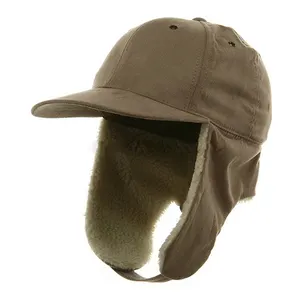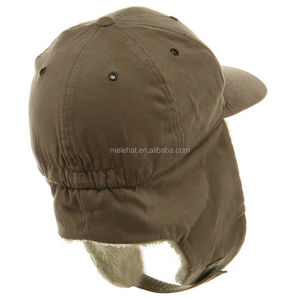
All categories
Featured selections
Trade Assurance
Buyer Central
Help Center
Get the app
Become a supplier

(149 products available)






















































Hunting caps with ear flaps are designed to provide warmth and protection during outdoor activities in cold weather. Here are some common types:
Classic Trapper Cap
The classic trapper cap is one of the most recognized hunting cap with ear flaps. It has a rounded design that fits snugly on the head with ear flaps extending down the sides. The ear flaps can usually be secured under the chin or on top of the head using straps or buttons. This style is prevalent among hunters and outdoorsmen because it offers excellent protection against wind and cold. They are made from materials like fur, sheepskin, or insulated synthetic fabrics, providing excellent warmth.
Bomber Cap
The bomber cap is another style of a hunting cap with ear flaps that originated from aviation. It features a close-fitting design with padded ear flaps that extend down the sides of the head. The ear flaps can be folded up and secured in place when not in use. Usually, the bomber cap is made from leather or robust, wind-resistant materials such as nylon or polyester. This cap style is lightweight and provides excellent protection against wind and light precipitation, making it suitable for milder cold weather conditions.
Hunting Cap with Flaps
This hunting cap with flaps is designed specifically for hunting and outdoor activities. It has long ear flaps that cover the ears and neck, providing extra warmth and protection. The flaps can be secured in different positions or folded away when not needed. Usually, hunting caps with flaps are constructed from camouflage materials to help conceal the wearer in the environment. They may also feature additional insulation or lining for enhanced warmth. They are ideal for cold weather hunting and other outdoor pursuits where camouflage is essential.
Fleece Ear Flap Cap
The fleece ear flap cap is a lightweight and versatile option for cooler weather. It has a snug, comfortable fit with soft fleece ear flaps that provide warmth and protection. The ear flaps can be secured under the chin or on top of the head. The fleece material is excellent for wicking moisture away from the skin and drying quickly, making it suitable for active outdoor pursuits such as hiking or skiing. This style is well suited for moderate cold weather conditions where flexibility and comfort are essential.
Convertible Ear Flap Cap
Convertible ear flap caps offer versatility for changing weather conditions. They feature removable or adjustable ear flaps that can be folded up and secured when not needed. Normally, these caps are made from water-resistant or windproof materials, providing excellent protection against the elements. They may also include additional features such as ventilation openings or moisture-wicking linings for enhanced comfort. The convertible design makes them ideal for various outdoor activities where conditions may change throughout the day.
Here are some wearing and matching suggestions for hunting caps with ear flaps:
Wearing suggestions
Wearing a hunting cap with ear flaps requires attention to comfort, functionality, and style. Normally, users should begin by selecting a cap that fits comfortably and snugly on their head. This prevents it from moving or falling off during outdoor activities. Additionally, users should look for adjustable straps or closures. For instance, Velcro or snaps that allow for a customized fit. This ensures the cap stays in place. Usually, the ear flaps should be folded down to provide warmth and protection from the elements. In some cases, they can be secured in place with buttons or ties to prevent them from blowing away.
Moreover, users should consider the material of the hunting cap. For instance, wool or fleece lining in the ear flaps provides extra insulation and comfort during cold weather. Also, they should look for a cap with a moisture-wicking lining to keep sweat away from their forehead. This enhances comfort during strenuous activities. Further, users should consider the color and pattern of the cap to blend in with their surroundings. This ensures they maintain camouflage in hunting or outdoor settings. Finally, prioritize practicality over aesthetics and choose a cap that offers the necessary features for the intended purpose. For instance, waterproof or windproof materials enhance the cap's performance in harsh weather conditions.
Matching suggestions
Matching a hunting cap with ear flaps complements various outfits by considering both functionality and style. Normally, wearers should pair the cap with casual outdoor attire. For instance, jeans, cargo pants, or camouflage clothing. This enhances its hunting and rugged outdoor aesthetic. Additionally, users should opt for neutral or earth tones. For instance, brown, olive, or gray. This ensures the cap blends seamlessly with their ensemble. Moreover, users should consider coordinating the cap with other accessories. For instance, gloves or scarves that have similar colors or patterns. This creates a cohesive look that is warm and practical. Further, they should incorporate the cap into layered outfits by wearing it over a beanie or headband for added warmth during colder months. Essentially, matching the hunting cap with ear flaps focuses on balancing functionality with style. This ensures comfort and a fashionable appearance in outdoor settings.
Q1: What materials are typically used to make hunting caps with ear flaps?
A1: These caps are made with different materials. Usually, they ensure warmth and comfort. Common materials are wool, fleece, and synthetic blends. Also, some caps incorporate leather or suede for durability. Moreover, waterproofing provides additional protection from the elements.
Q2: How do ear flaps attach to the hunting cap?
A2: Typically, the ear flaps are attached to the sides of the hunting cap. They can be secured using various methods. For instance, buttons, snaps, or Velcro closures are common. Additionally, some flaps fold up into the cap itself when not in use.
Q3: Are hunting caps with ear flaps suitable for all types of weather?
A3: Yes, hunting caps with ear flaps are designed for different weather conditions. For cold weather, they provide insulation and wind protection. On the other hand, waterproof versions handle rain and snow. Additionally, some are made with lighter materials for milder conditions.
Q4: Can ear flaps be adjusted for a better fit?
A4: Many hunting caps feature adjustable ear flaps. Usually, they can be secured with straps, Velcro, or snaps. This allows for a customized fit over the ears. Consequently, it ensures comfort and warmth as needed.
Q5: Do hunting caps with ear flaps come in camouflage patterns?
A5: Yes, hunting caps with ear flaps are available in various camouflage patterns. This makes them blend into different environments. For instance, woodland, desert, and snow patterns are common options. Besides, they help hunters remain inconspicuous to wildlife.